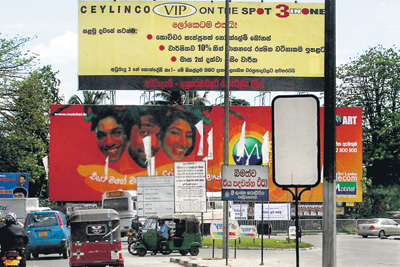
Hoardings in Colombo – are they illegal?By Tharindri Rupesinghe The hoarding issue is a heated one that has been gathering momentum over the past few months and the Colombo Municipal Council (CMC) which is the approving authority for the hoardings has come under fire for lax approval of these hoardings. To discern the legal factor, The Sunday Times FT looked into the guidelines on Advertisement Fixtures which was structured by the immediately former Mayor and his deputy and passed by the Supreme Court which were also given the stamp of approval by the Municipal Commissioner. Some of the key points are as follows:
For firms to put up the hoarding, the location and process have to be certified by the Council which in turn presents the firm with a reference number which has to be printed on the hoarding, along with the contact details of the applicant of the advertisement and the phrase, “city complaints -www.cmc.lk”. The license is valid for up to one year generally. Former Deputy Mayor of Colombo, Azaath Salley has been involved in the issue for some time now. He says that during his tenure as Deputy Mayor in the 2002-2006 periods, he supervised the removal of 386 advertising hoardings. According to him, right now in Colombo, there are a number of hoardings of which the reference number has expired or been duplicated and some that have been approved for one location but have been out up in another. He points the finger at former CMC Commissioner Jayantha Liyanage, alleging him of “haphazardly approving the hoardings around Colombo.” Legal matters Revenue Damage The strength of the hoardings is the responsibility of the city officials. “The structural safety and stability” of the hoarding is to be certified by a Civil Engineer within seven days of the hoarding being erected, says the guidelines, but if this actually happens is doubtful. |
|
||||||
|
||||||
| || Front
Page | News
| Editorial
| Columns
| Sports
| Plus
| Financial
Times | International
| Mirror
| TV
Times | Funday Times || |
| |
Reproduction of articles permitted when used without any alterations to contents and a link to the source page.
|
© Copyright
2008 | Wijeya
Newspapers Ltd.Colombo. Sri Lanka. All Rights Reserved. |
 For the past few years, pedestrians in Colombo city have been forced to deal with the looming menace of advertising hoardings planted smack in the middle of every available pavement space in the city.
Not only are the hoardings placed in such a way that pedestrians are forced to walk on the roads, but some are also not high enough from the pavement, causing head injuries.
For the past few years, pedestrians in Colombo city have been forced to deal with the looming menace of advertising hoardings planted smack in the middle of every available pavement space in the city.
Not only are the hoardings placed in such a way that pedestrians are forced to walk on the roads, but some are also not high enough from the pavement, causing head injuries.